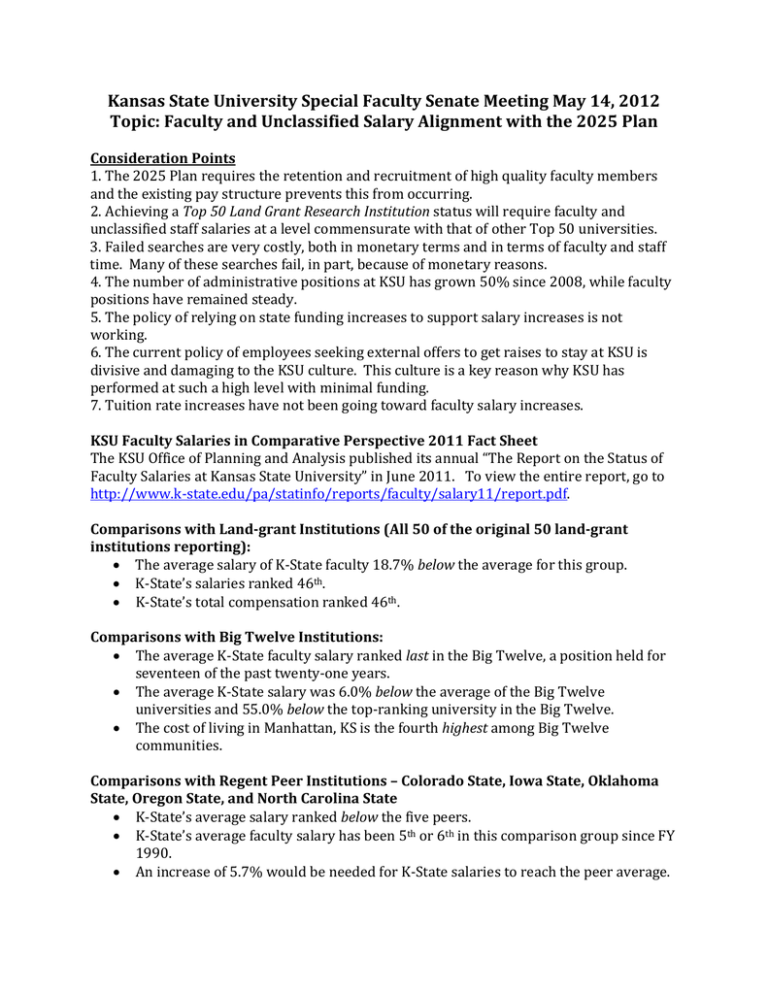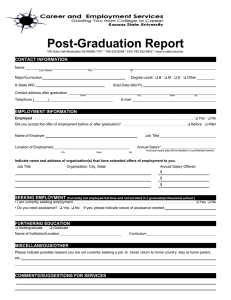Document 12980601
advertisement

KansasStateUniversitySpecialFacultySenateMeetingMay14,2012 Topic:FacultyandUnclassifiedSalaryAlignmentwiththe2025Plan ConsiderationPoints 1.The2025Planrequirestheretentionandrecruitmentofhighqualityfacultymembers andtheexistingpaystructurepreventsthisfromoccurring. 2.AchievingaTop50LandGrantResearchInstitutionstatuswillrequirefacultyand unclassifiedstaffsalariesatalevelcommensuratewiththatofotherTop50universities. 3.Failedsearchesareverycostly,bothinmonetarytermsandintermsoffacultyandstaff time.Manyofthesesearchesfail,inpart,becauseofmonetaryreasons. 4.ThenumberofadministrativepositionsatKSUhasgrown50%since2008,whilefaculty positionshaveremainedsteady. 5.Thepolicyofrelyingonstatefundingincreasestosupportsalaryincreasesisnot working. 6.ThecurrentpolicyofemployeesseekingexternalofferstogetraisestostayatKSUis divisiveanddamagingtotheKSUculture.ThiscultureisakeyreasonwhyKSUhas performedatsuchahighlevelwithminimalfunding. 7.Tuitionrateincreaseshavenotbeengoingtowardfacultysalaryincreases. KSUFacultySalariesinComparativePerspective2011FactSheet TheKSUOfficeofPlanningandAnalysispublisheditsannual“TheReportontheStatusof FacultySalariesatKansasStateUniversity”inJune2011.Toviewtheentirereport,goto http://www.k‐state.edu/pa/statinfo/reports/faculty/salary11/report.pdf. ComparisonswithLand‐grantInstitutions(All50oftheoriginal50land‐grant institutionsreporting): TheaveragesalaryofK‐Statefaculty18.7%belowtheaverageforthisgroup. K‐State’ssalariesranked46th. K‐State’stotalcompensationranked46th. ComparisonswithBigTwelveInstitutions: TheaverageK‐StatefacultysalaryrankedlastintheBigTwelve,apositionheldfor seventeenofthepasttwenty‐oneyears. TheaverageK‐Statesalarywas6.0%belowtheaverageoftheBigTwelve universitiesand55.0%belowthetop‐rankinguniversityintheBigTwelve. ThecostoflivinginManhattan,KSisthefourthhighestamongBigTwelve communities. ComparisonswithRegentPeerInstitutions–ColoradoState,IowaState,Oklahoma State,OregonState,andNorthCarolinaState K‐State’saveragesalaryrankedbelowthefivepeers. K‐State’saveragefacultysalaryhasbeen5thor6thinthiscomparisongroupsinceFY 1990. Anincreaseof5.7%wouldbeneededforK‐Statesalariestoreachthepeeraverage. K-STATE SALARY BENCHMARKS – Approved by Faculty Senate May 8, 2012 By 2015, salaries of K-State faculty and unclassified staff will be equal to or exceed 85% of the median salary level of faculty (according to rank and academic discipline) and unclassified staff (according to title) at land grant institutions ranked among the top 50 public research institutions. By 2018, salaries of K-State faculty and unclassified staff will be equal to or exceed 90% of the median salary level of faculty (according to rank and academic discipline) and unclassified staff (according to title) at land grant institutions ranked among the top 50 public research institutions. By 2021, salaries of K-State faculty and unclassified staff will be equal to or exceed 95% of the median salary level of faculty (according to rank and academic discipline) and unclassified staff (according to title) at land grant institutions ranked among the top 50 public research institutions. By 2025, salaries of K-State faculty and unclassified staff will be equal to or exceed the median salary level of faculty (according to rank and academic discipline) and unclassified staff (according to title) at land grant institutions ranked among the top 50 public research institutions. **K-State salaries, on average, are currently at 77.5% of the median for faculty and unclassified staff at land grant institutions ranked among the top 50 research institutions. Benchmarking Principles: 1. Purpose. Compensation benchmarks are standards by which progress toward salary goals can be judged. These salary benchmarks are based on the overall goal of K-State 2025—that K-State becomes a top 50 public research university by 2025. Many of the themes, activities, and outcomes of K-State 2025 depend upon retaining and recruiting a “highly talented, diverse workforce.”1 This set of benchmarks is focused on this purpose; not on other issues related to compensation (e.g., merit, compression, equity). 2. Clear, Measurable, and Flexible. Compensation benchmarks should be clear and measurable. This set of benchmarks compares the total compensation of like groups (e.g., assistant professors of history) using data from objective sources (i.e., AAUP and CUPAHR). How additional resources are distributed among those groups (e.g., across the board, merit, or some other way) will be decided when additional resources become available. 3. Reasonable and Graduated. Salary benchmarks should be reasonable and realistic given the current status of salaries and the goals, themes, activities, and outcomes of K-State 2025. FSLC believes these salary benchmarks are reasonable and graduated given our current context. 4. Comparison Groups and Data Sources. This set of salary benchmarks is based on the median salaries of like groups at land grant institutions—the institutions that most closely resemble Kansas State University and its mission. AAUP data will be used to compare faculty salaries. CUPA-HR data will be used to compare unclassified salaries where appropriate. 1K‐State2025,Theme5:FacultyandStaffStrategicActionPlan.




